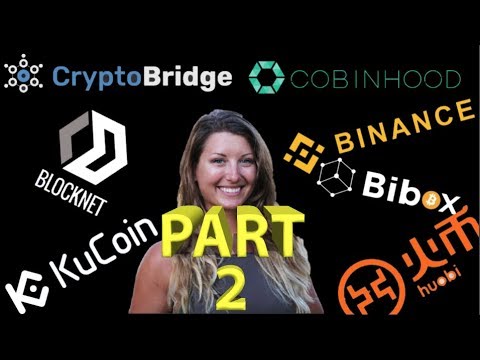Thinking about purchasing a Ledger Nano Hardware Wallet? Browse their official website: https://www.ledgerwallet.com/r/67ef
Want to join coinbase to begin your crypto journey? Here’s a link to get free $10: https://www.coinbase.com/join/558828d
Step up your game and Check Out Binance too: https://www.binance.com/?ref=10080191
Join the Robinhood app and invite your friends to Robinhood and win free stock. Here’s my invite: http://share.robinhood.com/heidic1
Find me on Steemit: www.steemit.com/@heiditravels
Twitter: @blockchainchick
Instagram: @hheidiann
LINKS FOR ADDITIONAL READING FOR THIS VIDEO & ALL INFO IN TEXT DOWN BELOW
FCoin:
https://www.coindesk.com/new-crypto-exchange-draws-fire-over-controversial-business-model/
https://support.fcoin.com/hc/en-us/articles/360005096773-Regarding-FCoin-s-Revenue-Distribution-Mechanism
Bibox:
https://www.marketbeat.com/cryptocurrencies/bibox-token/
https://www.cryptoglobalist.com/2018/05/21/three-facts-why-bibox-token-bix-has-been-bullish/
Halo:
https://www.haloplatform.tech/
https://steemit.com/cryptocurrencies/@andrewingram/halo-crypto-trading-evolved-part-1
Blocknet:
https://www.blocknet.co/
https://github.com/BlocknetDX/blocknet-docs/blob/master/blocknet-staking-guide.md
FCoin is a centralized exchange based in China that was founded by the same man who was the CTO Huobi. It was launched only a couple of months ago.
Here are some notable aspects to the design of FCoin:
Total of 10 Billion supply, awfully big number
Trans-fee mining
51% of all FCoin will go to the public, 49% is allocated to FCoin itself and its investors.
Instead of going the ICO or airdrop route, FCoin’s method of coin distribution is different. You just need to make a transaction, or trade on the exchange, pay the transaction fee in BTC or ETH and you’ll get that equal amount back in FCoin. I mean, technically it’s different from an ICO, but the concept is the same.
The benefit for holding FCoin is that 80% of the fees collected are distributed in the form of BTC to all holders of FCoin.
If the only real benefit for holding FCoin is to ultimately receive more Bitcoin, it seems the motivation to make trades decreases considering that you still pay 100% of the fees in BTC or ETH.
This next one seems a bit boring compared to FCoin, but it’s still new and has potential all the same.
Bibox: (BIX)
Much like the other exchanges covered in Part 1 of this series, Bibox is a Chinese exchange that has a native token called BIX, it’s an ERC20 token actually. Bibox distributes 20% of its profits to BIX holders on the condition that you make at least one trade a week on that exchange.This one has the same model for discounted trading fees and as Binance, 50% for the first year and this halves each year after until eventually no discount is applied. Also Bibox does the same token buy backs and burnings. Final supply of BIX will be 200 million.
Bibox has also developed a method to standardise its listing and delisting decisions.
If you’re bummed that you missed the beginnings of Binance or KuCoin, Bibox could be what you’re looking for.
The Halo platform will allow you to add any crypto exchange account you have (assuming that exchange has an API) and access it through its platform. It’s wallet will also allow you to store any cryptocurrency.
However, this kind of centralisation begs the question of its security measures, so as always, I’ll encourage you to dig deeper into this and see how you feel about its security implentations.
Halo is also going to be way more than just an exchange, they’ve got plans for creating a marketplace, providing business tools, and a customizable dashboard for a personalised crypto experience.
At the moment if you hold Halo coins, you can participate in its master node system and receive rewards that way.
When the exchange goes live you can expect this mid December 2018 if all goes well with the timeline they’ve set.
So, holders of Blocknet’s coin, called BLOCK can benefit in a lot of ways, but mainly, its staking mechanism is one of the most profitable I’ve seen yet. They offer three types of nodes for holders of BLOCK, Service nodes, Staking nodes and Trading Nodes. If you want to trade using Blocknet DX, you’ll need to run a trading node which only requires that you synch the wallets of the coins that you’d like to trade. If you want to earn rewards, you can run a staking node, for which there is no minimum required, but you will need to keep this running at all times to receive rewards, which can range from 9 to 14% in annual returns. Then there’s the service nodes, this one has a minimum requirement of 5,000 BLOCK to qualify, this node will reward you with 18% annual returns.


















?Woohoo, woohoo…? Blocknet shoutout ?, yet another quality video, my personal favorite part starts around 6:40 until the end. Such a sweet ending.
Oregon
Make a video on the difference bet proof of work,proof of stake
Denmark
You never seem to mention the project with the most substantial corporate adoption: Ripple XRP. Or maybe I just missed it 🙂
could be Cornwall or in that vicinity.
Thanks, Heidi; I didn't know Block had 3 node types. Had to laugh at "decentralised exchanges trading volume doesn't quite compare to centralised exchanges". DEXs have a long, long way to go yet.
FOMO3D is genius. Check it out.
wassa wassa wassa Fcooooooin! It will change the world as you know it lol
You forgot Kyber Network and Bitshares. Two great coins also imo
you survive the crypto crash of January?
Nice to see Blocknet getting some attention! Would just like to note that Blocknet is first and foremost an interoperability protocol allowing different blockchains to communicate and interact with each other allowing for the development of multi-chain architectures and applications which is what's needed for real world solutions and adoption.
You should look at Trade.io looks like it will be a great exchange with a native coin!
My picks: BIX, BNB, ONION, BTC.
WA state
Some part of Great Britain i see GB Youtube
Let me know if u are in Ireland, will show u around ?
Thanks again….what about COSS?
Why is there a video called "why I don't have eyebrows" in your suggested vids, Heidi? LOL. Anyway, I was on Geoguessr recently and that landscape looks a lot like NZ, Ireland, or England/UK.
Great review as always. Wish you would do one for SciDex already!!!!
love that you keep it moving (literally!)
FCoin is the reason Gas fees are 10x higher than they should be. Their selfish business model should be discouraged and left to die off.
I'm a fan of 0x (ZRX) which is going to be used by many decentralised exchanges.